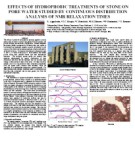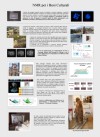 |
||
|
POSTERS |
||
| |
||
|
|
||
|
|
||
|
Effects of
hydrophobic treatments of stone on pore water
|
||
|
The effects of protective hydrophobic products applied to porous media such as stone or mortar vary greatly with the product, the porous medium, and the mode of application. Nuclear Magnetic Resonance (NMR) measurements on fluids in the pore spaces of both treated and untreated samples can give information on the contact of the fluid with the internal surfaces, which is affected by all the above factors. Continuous distributions of relaxation times T1 and T2 of water in the pores of both synthetic and natural porous media were obtained before and after hydrophobic treatment. The synthetic porous media are ceramic filter materials characterized by narrow distributions of pore dimensions and show that the treatment does not produce large changes in the relaxation times of the water. For three travertine samples most of a long relaxation time component, presumably from the largest pores, remains after treatment, while the amplitude of an intermediate component is greatly reduced. For three pudding-stone samples, treatment leads to a substantial loss from the long component and an even greater loss from the intermediate component. click on the image to download the
poster (1500KB) |
||
|
|
||
|
NMR per i Beni Culturali
|
||
|
|
||

